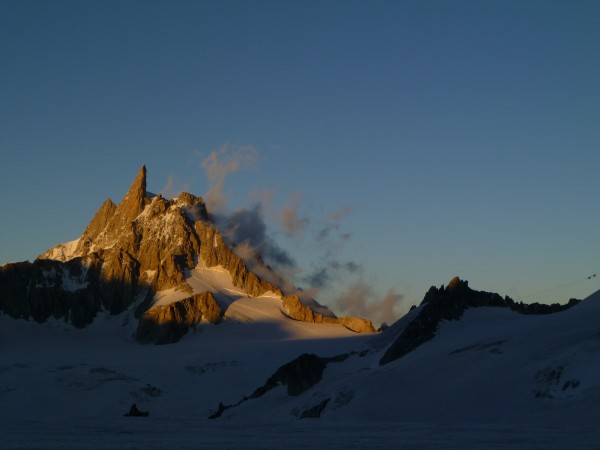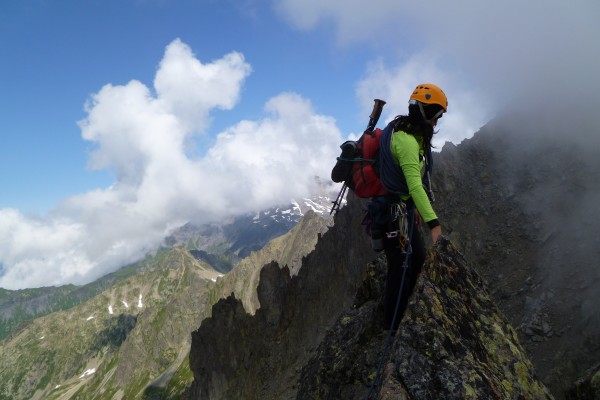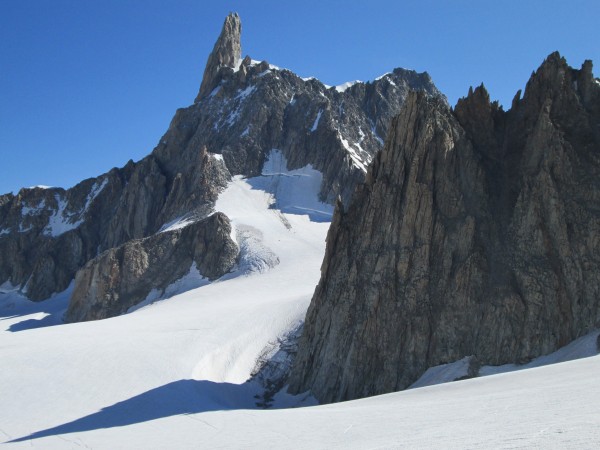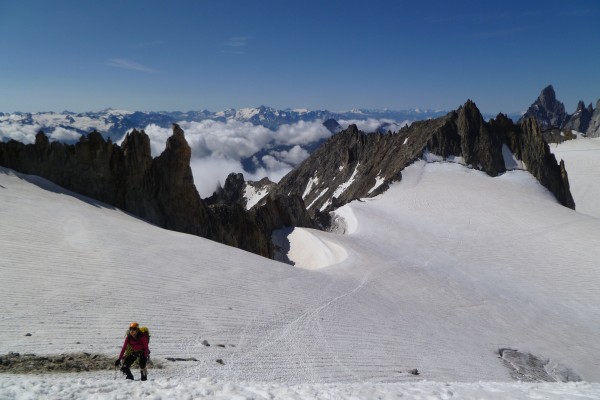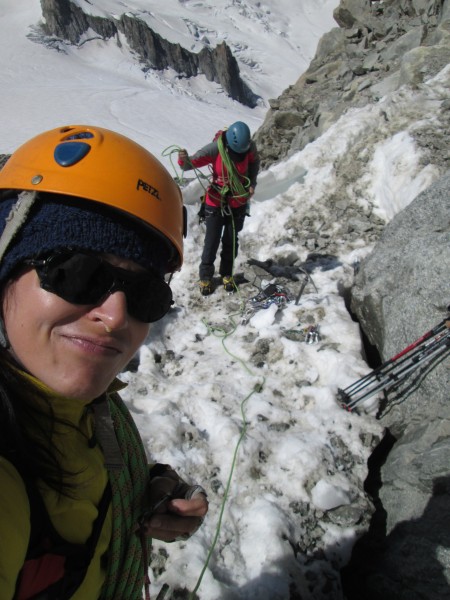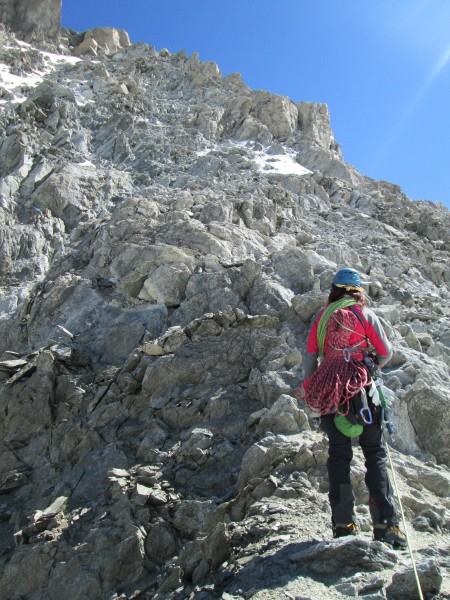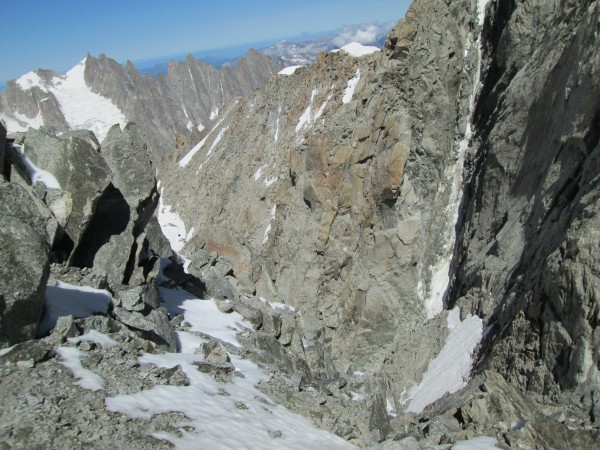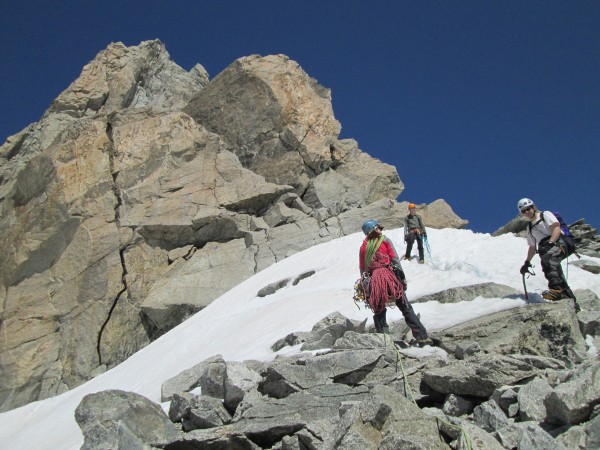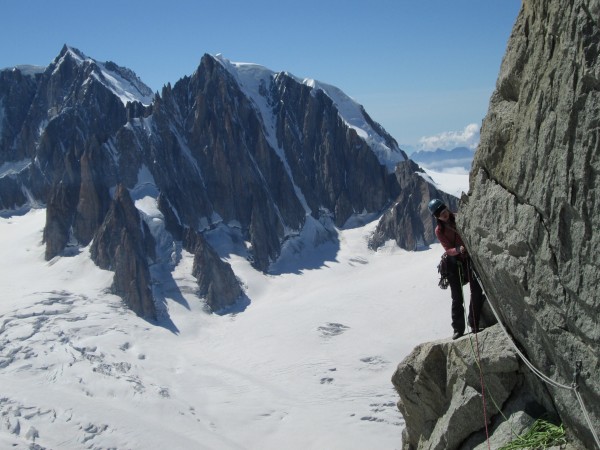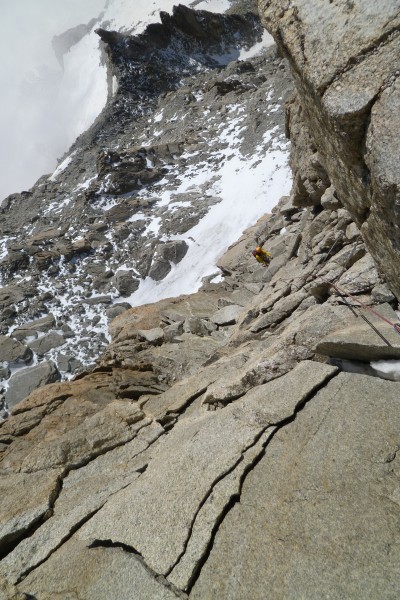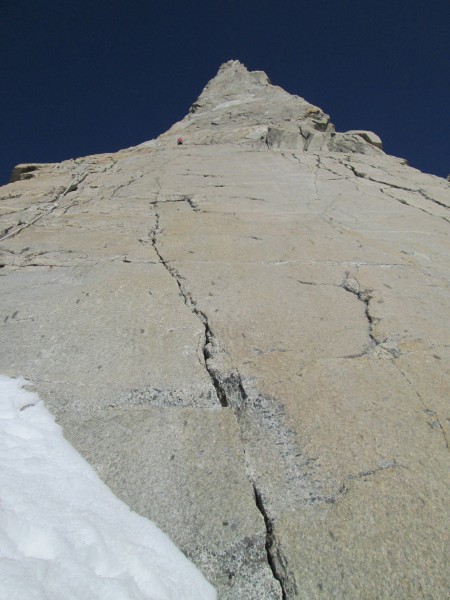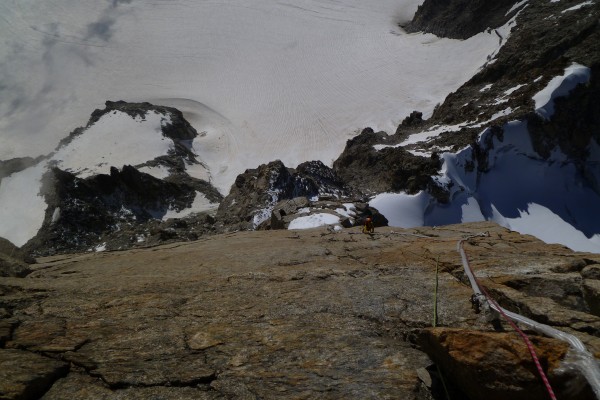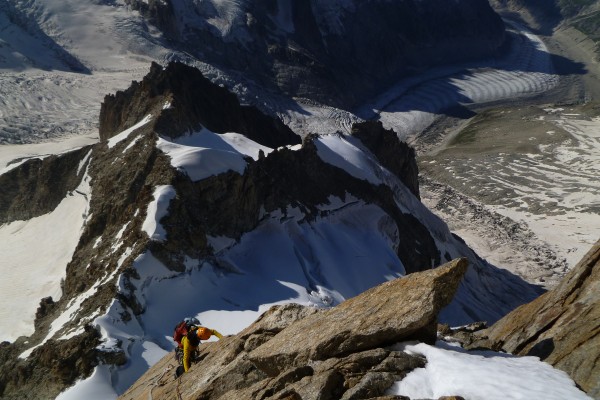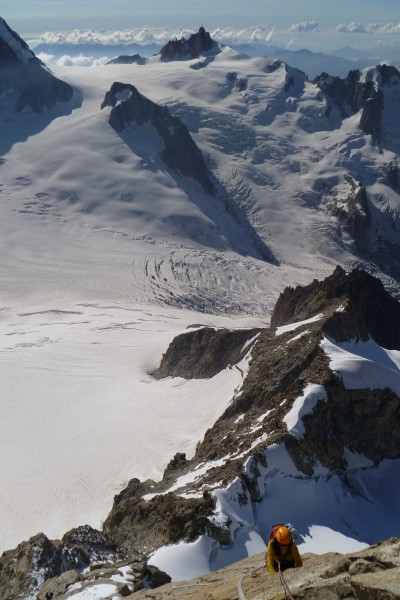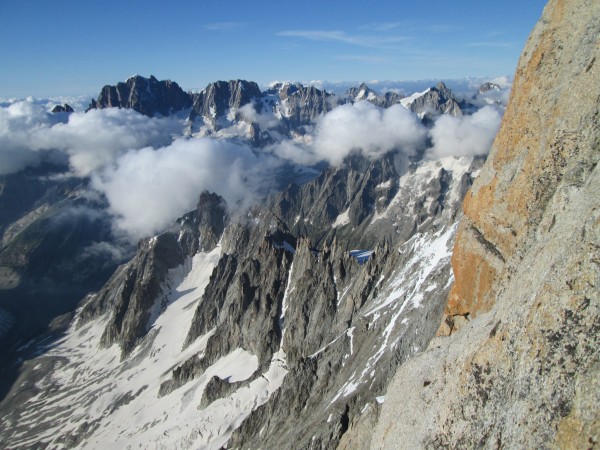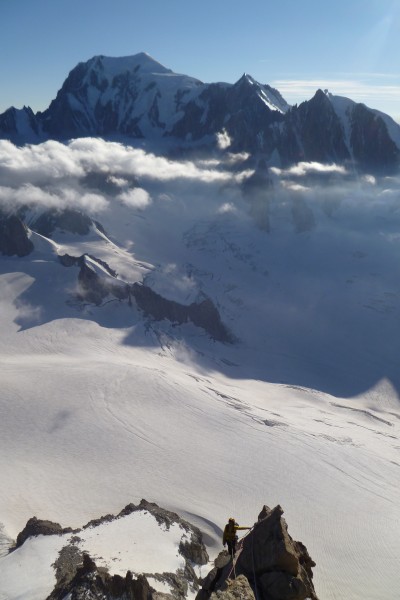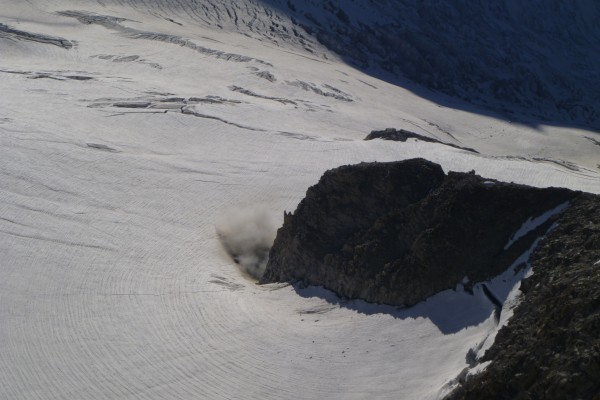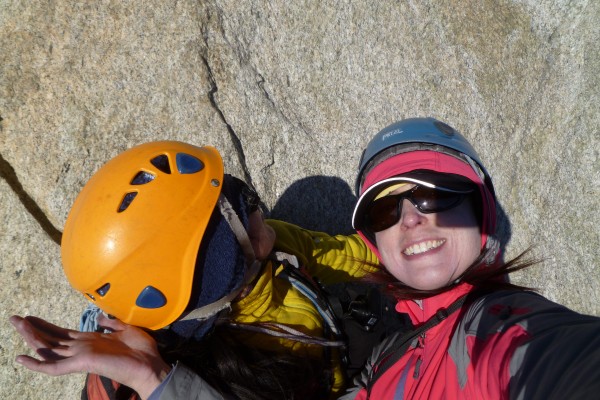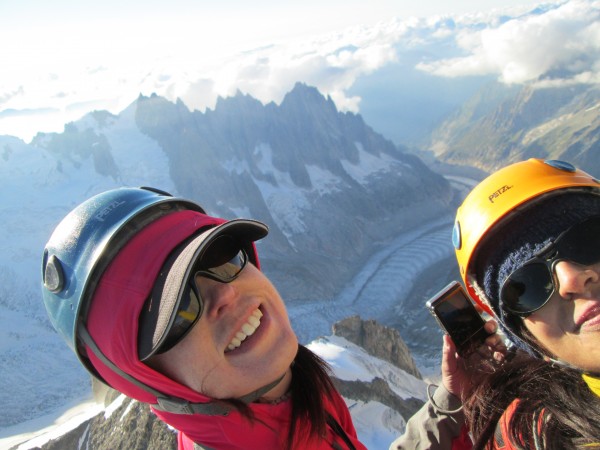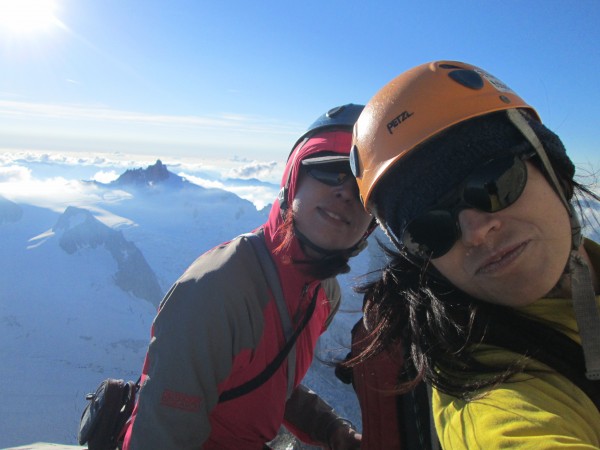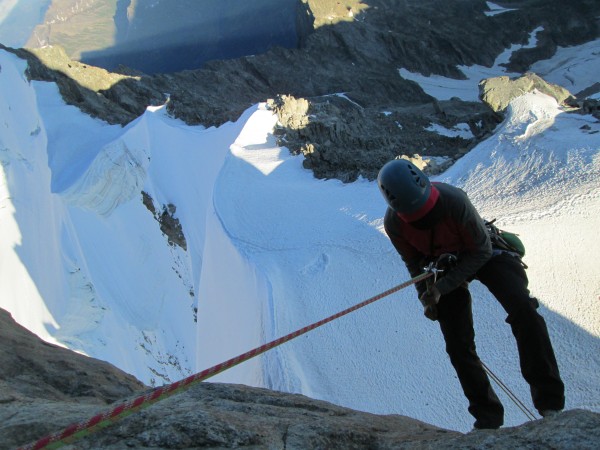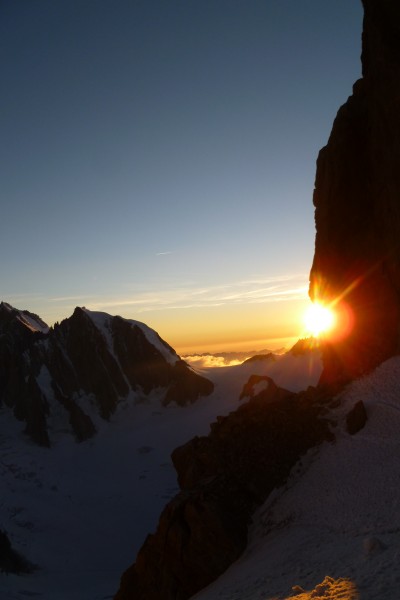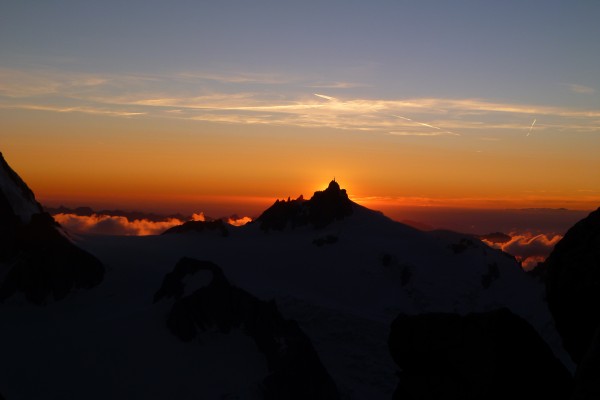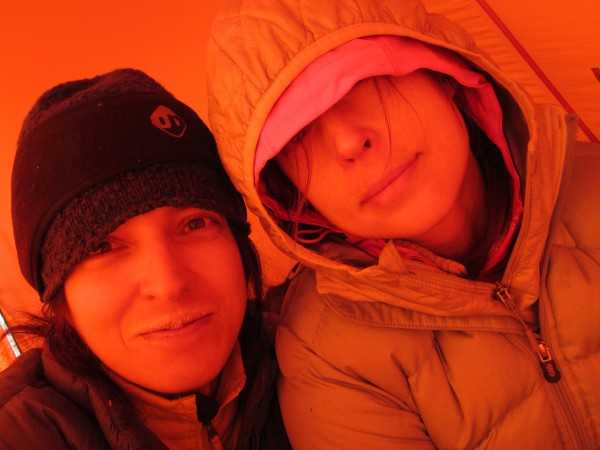This is not a comprehensive trip report of my entire stay by any means. I’m only pickin’ one day in the mountains. In fact, it was the easiest route we climbed. But it had the best views and the most epic surrounding story, and therefore it wins the TR lottery since I’m short on free time for idle fancies and storytelling these days (it took me three months total to write this, see). I apologize in advance for the lengthy prose, but I think you'll find it worth it, if only for the photos.
THE STORY BEGINS:
The Dent du Géant is probably one of the most-climbed pieces of rock in the French Alps. No doubt because it has an easy though technical route to the summit, as well as short 5.10 and 5.11 routes next door, so it is frequently ascended by climbers of all abilities as well as guided every day of the week. It is a small but compelling-looking piece of granite which stands out as a signature landmark for miles around. The summit is also quite mind-bending, ascending a knifeblade to a tiny perch with 360° views into France and Italy of the most beautiful terrain imaginable, encompassing green valleys, white peaks, rocky ridges and spires, glaciers and alpine mists.
Our modus operandi on this trip was to watch the weather carefully, planning our trips in the mountains during the good windows, and holing up in my partner’s Chamonix apartment when it was not to rest and recover. We had not really considered climbing the Dent, but while riding the Helbronner cable car back home one day, we ended up sharing it with two handsome Norwegian guys who had just climbed the peak. After talking to them, it piqued my interest more, so we looked up beta while back in town. It was one of the routes my partner had not climbed yet during her one year tenure there. So we gathered beta on our options, preferring to climb the newer and harder route Géant Branché to the left of the traditional summit route if possible. It was 460-600 feet (depending on what you read) at what seemed to be a reasonable grade of somewhere in the 10- range (more on that uncertainty later) stacked on top of a big approach.
The main crux for me was the time of day the Dent is typically climbed. Most people start the approach as early as 5am, climb the southwest-facing routes fully in the freezing shade, and descend by midday or mid-afternoon. Unlike my hardened alpine partner and all the other Euros in the area, I had been struggling since the start of my trip to deal with freezing pre-dawn prep and shady climbing on ice-cold rock due to the effect the temps had on my hands (compounded by probable Raynaud’s…how am I ever gonna be an alpine climber? For the record, I had a breakthrough in tolerance by about 14 days in…but this was before all that.) I told my partner I could absolutely NOT climb the Dent in the shade. Unthinkable. It had to be in the sun. Not to mention I wanted to avoid at all costs the hordes which flock to it. She told me it was maybe possible to get a later start, climb in the afternoon, descend, and then camp on the glacier the following night (vs the previous) before catching the cable cars back out, but first she had to call a guide friend to check if it would be safe for us to ascend when conditions were warmer (and more volatile). He confirmed yes, it should be okay, so that became our game plan.
In the meantime, we had a couple days to kill with mostly good weather. We needed some recovery from the last foray out, but my partner was anxious to do something during the okay forecast anyhow. I was more reluctant, feeling fatigued, but eventually we agreed on a day jaunt to the Aiguilles Rouges side of the valley, an easy, alpine-y traverse on the south ridge of the Chapelle de la Glière which we could mostly simul and solo with only occasional belaying.
We were pushing it to catch the last Index tram down the mountain later that day after navigating an approach and descent we found not trivial physically or dead-easy in routefinding. In other words, after a not-so-restful day, we arrived home and then prepared for the Dent. We packed up and planned to get the first car out to the Midi the next morning, a short walk from the apartment. My partner had no alarm clock but I relied on her to always wake us up on time. Somehow she did, being in a perpetual cat-napping state when not out in the mountains.
We arose in the pre-dawn, made cowboy coffee and breakfast while putting together last things and getting half dressed, waiting til the last minute to put on all our layers and boots and begin the overheating. I felt full even though I hadn’t eaten for hours, but I forced myself to eat the morning meal, choking it down as usual, because I knew I would be hungry soon enough if I didn’t.
Somehow, being just a little too sluggish, we didn’t leave the house on time and managed to catch only the second car out. Rats. At least riding the cable cars in the morning is less of a sh#t show for climbers and all their pointy objects than later in the day when sardine packaging becomes the requirement.
In the Midi station, we queued up for the Helbronner tram and soon we were well on our way, sailing sanguinely through the sky in the now-familiar alpine glory. We arrived in the Helbronner station and quickly dispatched ourselves to the cloudless but windy and cold mountain setting. Donning crampons, we scuttled through the crowds of Italian tourists standing around and headed east down the glacier. We planned to leave our packs wherever we found a flat spot and bivy there later. Once we felt we were suitably far away from curious passersby at a good place, we dropped the packs, assembled our gear, ropes, water, food, and clothing for the day, and headed off without a second glance back. Like many formations, the Dent looks soaring and huge in stature from far away but appears less and less massive as you approach it. Regardless, it is a decent walk over the glacier, dropping down into a small valley, and then back up a monstrous hill to the start of the choss part of the approach, culminating in a 2000’ hike. Most of the beta we read said the approach is typically two hours and so we allowed for this as we were both acclimated and relatively strong hikers. We were carrying gear for the harder Géant Branché route -- which meant doubles of most cams and several more slings plus more water than usual due to the strenuous start to the day.
We had not roped together for any part of the approach until this point, so we lassoed up.
At first it was easy to follow the trail and the rock was not too poor.
However, things quickly deteriorated.
Eventually we encountered some people already descending, those who clearly started this whole process in the dark. There appeared to be as many guides as not and the majority of their clients struck my jaded heart as gumbies. Who cares if you go up at 6am or 11am? There would be no limit to the supply of inexperienced souls who could knock sh#t down whether going or coming. At one point I saw a relatively large group preparing to slowly downclimb a 5th class section. I didn’t really want to compete or wait for them nor even be below them, so I decided we should detour around. Little did we know that there is actually ONE AND ONLY ONE trail to the Dent. I mean, sure, you can go other ways, but you aren’t going to enjoy it and you might not even survive it.
We soon found ourselves in sections of terrain so loose it took all our skill not to tumble down or release mini-avalanches. At one point, I realized we would need to belay over one particularly rotten section of ice mixed over sand and rock. I “led” up over a 40 foot section of this (with pro, you ask? ha ha) into massive loose blocks perched precariously on the shifting pile of pulverized granite. I finally found one place that took a single cam--which didn’t feel anchored to a house of cards--and put Irina on belay. She came up and then I prepared to lead out a traverse over more steep, rotten rock which would regain the actual trail again after about 70 feet. We were both tucked at the base of a pile of massive boulders. About one minute before I left the belay and broke off into open terrain, we heard a sudden noise and many people screaming and shouting above us. In milliseconds rockfall starting raining down in that space, mostly microwave-sized pieces glancing off at every random angle Newtonian physics allowed. I had experienced killer rockfall coming down past me on one route before but it didn’t come close to this in size. After an unknown period of terror, it was over as instantly as it began and all that echoed in its wake were people screaming at the culprits in French and English to not be such f***ing ----!!! Immediately following that we all screamed to each other to reassure our health and alive-ness. Insanely, no one was killed or hurt. After calming my nerves, we belayed each other back over to the trail in a flash and continued on as fast as possible, realizing there was nowhere to run or hide and no way to avoid this for the rest of the approach.
Two or three times we encountered a few steep snow patches. There were good steps kicked in so I plunged ahead with just my axe and no crampons and all was well. This was good. This meant time saved. But the reality was we were progressing slower than anticipated anyway. The fatigue in our legs from our previous day’s adventure and the little recovery time between trips was showing itself. My error in attempting to bypass people off-route had not helped. When we were nearing the base of the Dent, we came to another large snowpack. Some British climbers coming down advised us to don crampons because it continued around the corner for some time and involved some narrow, do-not-slip territory.
Then – we were finally there. We really needed to rack up and start climbing immediately but we absolutely had to eat and take a very small break first. At that point we realized the approach had taken us an hour longer than anticipated. I was shocked and dismayed, particularly considering we were both hiking fairly strongly on most trips. Despite the fact that the route was only about 6 pitches give or take at 10a or less, I have been climbing long enough to know it was a bad idea to underestimate how long it “might” take. Adding to the uncertainty was the reality that it was not completely clear exactly what the true grade of the route was. Many routes in the Alps are graded using the alpine system…which did not come across as incredibly precise to me due to the complexity of factors it takes into account. Topos would then often have pitch grade breakdowns which added confusion as they used ratings from a variety of systems, usually French or British or something else, but I had not always found them to be consistent, sometimes feeling up to two letter grades apart on the YDS system.
We decided the only smart idea at that point was to climb the Voie Normale route which was the same length but far easier and would allow for speed. We had a huge and complicated descent involved and did not want to be doing it in the dark. We decided the fastest way to climb (and the warmest) would be for me to lead all the pitches and Irina to second. There was also the fact that she could come back and lead it any time she wished, whereas I could not. The Voie Normale is often climbed in boots but I decided to wear climbing shoes while Irina chose to stay with her current footwear. I racked up quickly with a set of singles and we were off!
The first 2-3 pitches are so blocky and easy you almost wonder where you are actually supposed to go. Occasionally old pitons appear, however, to notify you that your instincts are correct.
Eventually we arrived at a huge belay ledge and this is where the really good stuff began. The southwest face rears up like a massive shield of shining, white/gold, bullet granite split by tiny, perfect cracks. Here is also where the bizarre cable system starts in earnest. I looked at the untainted crack system to its right; so alluring, so beautiful. But it was difficult to know if it would be as easy as the actual route and if the crack continued accepting gear all the way to the next belay. Since we had no time to waste, I decided to plug and chug into the known vs the unknown. This crack was also fun but exceedingly polished and slippery, reminding me more of Valley classics than alpine granite. The cable seemed unnecessary on this pitch although I wasn’t sure in what conditions people continued to climb the route.
After that, the headwall continued at a much steeper angle, mostly dead vertical. Here the cable was actually necessary as the cracks were often discontinuous and the moves unprotected. This would not have mattered except that some of these sections actually appeared to have somewhat difficult and thought-provoking face moves off polished slopers and small, glassy holds…or just no holds at all in a place or two. After a few seconds of checking out the potential sequence, I did not hesitate to batman up the rope in these cases, the slowly sinking sun always in my mind. The route was supposedly in the 5.6 to 5.7 range, but I wondered (and still do) if that indicated the grade all free or if it was actually 5.6 A0. The brief vertical, blank, slippery sections just did not seem to jive.
Eventually the verticality eased off and I began to crawl up the undulating knifeblade finish, bopping along just off its southern exposure. After surmounting every new jagged hook on the blade, I kept expecting to be on the summit. But the Dent goes longer than expected, the cable continually winding away before you, a clear sign it’s not over til it’s over. Up and up I went, placing almost no pro, but still the ropes began to drag on me as the snaky ridge, stacked with alpine blocks, took its toll. Eventually I reached the anchor, hunkered down, and put my partner on belay. We had had no real communication between belays for a while at this point, the cold, gusty alpine wind too jealous to allow such exchanges. With easy climbing, few pieces to remove, and a sinking sun, she arrived quickly.
At this time we knew we were the only people on the Dent except for two men just behind us. I really wanted to climb just a bit further to the other summit and sit next to the Madonna statue which keeps her place eternally there, but the sun’s position and the thought of our bivy far away was pressing on my conscience, so we settled for a mere hundred celebratory summit photos instead (of which I will share only three with you).
Three double rope raps off the shorter backside of the Dent brought us to the snow. (For the record, the dudes behind us said they had brought their bivy gear up with them and planned to stay at the base, so we would not be having company on the descent…for good or for bad.)
Irina ran off to fetch my boots and I began coiling the ropes. Soon we were packing up, donning every shred of clothing we brought, and racing the fading light. I was cursing the fact that sunset was upon us. We hadn’t climbed slowly on the route at all. Why was this happening to us? I had vowed not to descend in the dark and now it was happening and there was nothing to be done but get on with it.
But the worst part? The earth had turned into a place of epic beauty and we could not help but steal moments to photograph the Midi silhouetted as we lost the sun. In fact, we had to force ourselves to start the concentrated task of looking at our feet and navigating the terrain as precisely and quickly as possible once a few images had been captured. The brain’s electrical recording of memories is so different from that of the mathematical renderings of image pixels on our cameras’ memory cards. The brain forgets the precise details of the moment but retains the essence of the memory, including the abstract emotional quality, and that is what I feel most as I sit here writing this.
The initial descent was easy in the dusk light and we removed our crampons as soon as we bypassed the initial snowfields. We held out on firing up the headlamps until visibility was so low we were trying to guess which jumble of rocks was the real path. The cold started to settle in and bite at our faces but the constant movement held it just at bay. At one point we reached the trickiest spot of all: a small promontory of choss that appeared to cliff out. We knew the path could feasibly go down either side but only one would be “right” and the other would be a horror-show of loose and deadly blocks. In full darkness it was hard to tell what lay beyond the edges of our headlamps, but we chose correctly, our combined skill giving us the intuition to read the landscape properly.
Eventually we came to the short, steep snowfields we had crossed easily in boots earlier. I paused at the edge of one, hesitating at the glittering white crust forming in my light beams. I loathed stopping to take the time to put on crampons but feared what could happen if I didn’t. Well-worn kicked steps were still present and shelf-like but not angled down against the slope of the hill as they traversed out of sight. I held my breath and decided to test it, plunging my axe into the snow and stepping out gingerly. Solid! The snow wasn’t frozen yet. I quickly crossed and encouraged Irina to do the same.
Further down we came to the last and steepest snowfield. This one required descent straight down versus across. Irina voiced her feeling that we should wear crampons and I agreed. We also felt a belay was necessary as it was later and colder and the snow was probably approaching frozen. Most of the choss surrounding us offered no suitable anchor opportunities, but we were both down with using single-point, hip-belay methods at that point -- which improved the odds of creating an “acceptable” anchor (n=1 and all that). One cam in and I was on my way down, the snowfield requiring a tricky 5th class move off a boulder down-slope which I knew Irina wasn’t going to like as the unprotected second. Oh well. Allez!
After setting up my single-cam belay and putting her “on” at the bottom, I had ample time to sit and freeze my ass off while she tried to negotiate the weird moves up above, out of eyesight and earshot. The wind had been wailing on us most of this time and it felt like the middle of the night. That was the one point I began to mentally break down a bit. Despite the fact we had not knocked off a single pebble yet and were more than two thirds done, I began to wonder if we would make it all the way in the night. Would we have to weather a miserable over-nighter on that pile of choss just before the end? Would one or both of us end up dead by a fatigue-induced stumble or unfortunate rockfall? It was all possible. Shivering uncontrollably, it was hard to think rationally and it felt like Irina was taking forever to reach me. But I remembered that we had a combined twenty years’ climbing experience and we certainly had the competence to get off that POS safely as long as our luck held.
Past the snowfield we unroped again and continued the scramble in crampons but I barely noticed the grating metal against rock. We soon dropped off the other side of the ridge and became sheltered from the wind. This small change dramatically improved my physical state and outlook. We reached the glacier below without incident, zero rockfall, located our stashed poles, roped up, and started the heinous trudge back to camp – wherever “camp” was … we weren’t sure at that moment in the dark.
We went downhill like zombies, not speaking. Neither of us had eaten or drunk water for hours. Hiking in crampons at that point was like murder on my fatigued ankles and lower legs. All of a sudden, I felt my foot break through the surface of the glacier! Holy shit!!! I yelled out to Irina that we were definitely heading into the crevasse minefield we had easily detoured in the daylight. “Left, left, go left!” I screamed and we did a heroic 60 yard crampon dash together.
Crevasse disasters averted, we reached the bottom of the mountain and began the next long uphill slog. What in the world time was it? We didn’t know. We didn’t want to know. At this point Irina began her own small mental breakdown. When my pace outstripped hers the rope would yank between us and she would scream out at me. At that moment it was the most annoying thing in the world I had ever experienced. I wanted to untie but didn’t want to take the time or remove my gloves. She started yelling that we were never ever gonna locate our packs, that it was impossible. It was just fatigue talking. I told her to be quiet and that we would find them by using the Helbronner station’s night lights as a guide. And it worked without incident. Eventually, after an eternity of rope-yanking and yelling, I saw our packs’ reflective tabs send their friendly signal via my headlamp in the darkness. We were headed straight for them! Yessss! Girls rule!
But it wasn’t over. We arrived and Irina had a small meltdown, saying she absolutely could not set up the tent. The tent was a new four-season Mountain Hardwear and it was a bitch to get it fully deployed, requiring exceptional hand and arm strength to hold the poles tight against each other. We both hated it. I communicated with the utmost delicacy in no uncertain terms that I was not going to f*#king sleeping on the f*#king glacier and if that was the way it was going to be I was heading straight for the Helbronner station. If she wished to sleep alone out there she was welcome to do so. I had checked the time when we arrived: 12:45 a.m. Damn. I immediately pulled out some liquid water and a package of salted almonds from my pack and administered them to my partner, reassuring her I would help her set the tent up. She agreed. As soon as we were under the canopy, working together to slide the dogged poles through the fabric, she remarked softly, “Oh…it is better already.” This induced fits of slap happy laughter from me and soon we had camp set up and were sitting side-by-side in our sleeping bags, eating crackers, cookies, nuts, and drinking hot tea. We passed out and slept in late, arising to another warm, cloudless day and our sky car waiting for us not far in the distance.
Was it worth it, you ask? Like I imagine many alpinists might say in hindsight of mountain adventures gone slightly awry from the plan, the answer is yes. After all, almost everything went right. And everyone lived happily ever after.
